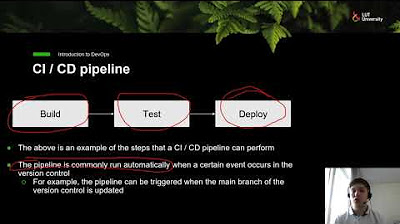DevOps & Continuous Delivery Lifecycle Explained
Summary
TLDRThe video explains the concept of DevOps, a methodology that bridges the gap between development and IT operations teams to deliver and improve software solutions rapidly. It outlines the challenges of traditional development, where conflicts arise between developers and operations teams, and how DevOps eliminates the 'wall of confusion.' By encouraging collaboration, continuous delivery, and automation, DevOps accelerates product releases and improves quality. The video highlights how DevOps changes team structures, workflows, and job roles, ultimately fostering faster and more reliable software development and deployment.
Takeaways
- 😀 DevOps is a methodology that breaks down the barrier between development (Dev) and operations (Ops) teams to improve collaboration and speed up software delivery.
- 😀 The traditional 'wall of confusion' between development and operations often leads to issues in product deployment and system reliability.
- 😀 DevOps is about the philosophy that developers should be responsible for how their code works in production, known as 'you built it, you run it.'
- 😀 Users demand fast, continuous updates, so businesses must rapidly release new features, even several times a day, to stay competitive.
- 😀 Conway's law suggests that the way we organize teams influences the software we build, so aligning teams to work efficiently together is crucial for quality software.
- 😀 DevOps teams are typically small, cross-functional, and work independently on specific systems or services, combining engineering, QA, security, and operations roles.
- 😀 Companies like Amazon and Facebook integrate testing into the development process, with engineers conducting unit tests and automated testing tools for code validation.
- 😀 A DevOps workflow, known as continuous delivery, ensures code is tested, integrated, and deployed in small increments with automated processes to catch bugs early.
- 😀 Continuous delivery practices rely on automation to speed up product releases, including automated testing and deployment pipelines.
- 😀 DevOps requires a cultural change within organizations, and companies may hire DevOps engineers to optimize workflows and automate processes to facilitate continuous integration and delivery.
- 😀 The success of DevOps can be measured using key metrics such as lead time, deployment frequency, mean time to restore service, and change failure rate, with high performers achieving significantly faster deployment and recovery times.
Q & A
What is the 'wall of confusion' in the context of software development?
-The 'wall of confusion' refers to the conflict between development teams and IT operations teams, where the two groups work separately with different goals and understandings. Developers modify products to add value, while operations ensure reliability, leading to communication and coordination challenges when deploying software.
What is DevOps, and why is it needed?
-DevOps stands for development and operations. It is a methodology and philosophy aimed at tearing down the wall of confusion between developers and IT operations teams. DevOps is needed to enable faster, more reliable software delivery, improve collaboration, and ensure the software works well in production environments.
What does 'You built it, you run it' mean in DevOps?
-'You built it, you run it' means that developers are responsible not only for writing the code but also for ensuring it runs properly in production. This concept helps improve the quality of the product by involving developers in operational responsibilities.
What are the advantages of DevOps over traditional software development methods?
-DevOps offers several advantages over traditional methods, such as faster product releases, better collaboration between development and operations teams, improved software quality, and a more agile response to customer needs. It also allows companies to deploy code multiple times a day, improving innovation speed.
How does Conway's law relate to DevOps?
-Conway's law suggests that the way teams are structured influences the architecture of the software they create. In DevOps, organizing teams around specific services or products ensures that their work processes align with the software they build, fostering better collaboration and faster development.
What is continuous delivery in a DevOps environment?
-Continuous delivery is a DevOps practice where code is frequently integrated and deployed through automated testing, version control, and deployment pipelines. It ensures that new features are released quickly and reliably, with minimal manual intervention.
What is the role of DevOps engineers?
-DevOps engineers are responsible for managing and automating the continuous delivery pipeline, writing scripts for integration and delivery, and monitoring system performance. They also play a key role in driving the cultural and workflow changes necessary for successful DevOps implementation.
What is the significance of automated testing in the DevOps workflow?
-Automated testing is crucial in DevOps as it ensures code is tested quickly and thoroughly, reducing the risk of bugs and ensuring quality. It allows for continuous integration and delivery by automating the process of detecting issues and providing feedback to developers.
How do DevOps teams typically work together?
-DevOps teams often consist of cross-functional groups that combine skills from software engineering, operations, quality assurance, and security. They work collaboratively on the entire software development lifecycle, from writing code to maintaining the product after release.
How does DevOps impact the performance of an organization?
-DevOps significantly improves an organization's performance by increasing the frequency of deployments, reducing the time between code commits and successful deployment, speeding up recovery from incidents, and lowering the failure rate of changes. High-performing DevOps teams deploy code more frequently and recover from issues much faster than low-performing teams.
Outlines

This section is available to paid users only. Please upgrade to access this part.
Upgrade NowMindmap

This section is available to paid users only. Please upgrade to access this part.
Upgrade NowKeywords

This section is available to paid users only. Please upgrade to access this part.
Upgrade NowHighlights

This section is available to paid users only. Please upgrade to access this part.
Upgrade NowTranscripts

This section is available to paid users only. Please upgrade to access this part.
Upgrade NowBrowse More Related Video

DevOps In 5 Minutes | What Is DevOps?| DevOps Explained | DevOps Tutorial For Beginners |Simplilearn

What does DevOps engineer mean to you?

What is GitLab?

Introduction to DevOps - CI / CD

What is DevOps? - DevOps explanation by WebGentle | Explained Dev

Explicando DevOps (infraestrutura, cultura e operações)
5.0 / 5 (0 votes)